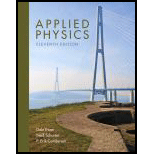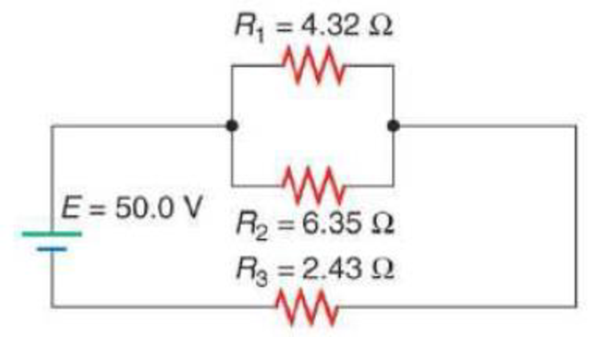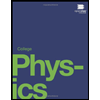
Applied Physics (11th Edition)
11th Edition
ISBN: 9780134159386
Author: Dale Ewen, Neill Schurter, Erik Gundersen
Publisher: PEARSON
expand_more
expand_more
format_list_bulleted
Textbook Question
Chapter 17, Problem 25RP
Find the current through R3 in Fig. 17.81.

Figure 17.81
Expert Solution & Answer
Want to see the full answer?
Check out a sample textbook solution
Students have asked these similar questions
Calculate the current if 7.3 C of charge passes through a point over 2.1 s.
KINDLY ANSWER IMMEDIATELY, THANKYOU FOR HELPING OUT
An electric broiler develops 400 cal per second when the current through it is 8 A. Determine the resistance of the broiler.
CHOICES:
A. 21.61 ohm
B. 2.61 ohm
C. 26.16 ohm
D. 6.16 ohm
Find the current density in a copper wire used for lamp cords with a diameter of 1.75 mm and carries a steady current of 12.5 A to a desk lamp.
Chapter 17 Solutions
Applied Physics (11th Edition)
Ch. 17.3 - Two identical charges, each -8.0010-5C are...Ch. 17.3 - The force of repulsion between two identical...Ch. 17.3 - A charge of +3 010-6C exerts a force of 940 N on a...Ch. 17.3 - A charge of -3.010-8 C exerts a force of 0 045 N...Ch. 17.3 - When a -9.0-C charge is placed 0.12 cm from a...Ch. 17.3 - How far apart are two identical charges of +6.00 C...Ch. 17.3 - Three charges are located along the x-axis. Charge...Ch. 17.3 - Three charges are located along the x-axis Charge...Ch. 17.4 - An electric field has a positive test charge of...Ch. 17.4 - What is the field magnitude of an electric field...
Ch. 17.4 - An electric field exerts a force of 2 5010-4 N on...Ch. 17.4 - An electric field exerts a force of 3.0010-4 N on...Ch. 17.4 - An electric field of magnitude 0.450 N/C exerts a...Ch. 17.4 - An electric field of magnitude 0.370 N/C exerts a...Ch. 17.4 - What force is exerted on a test charge of 3.8610-5...Ch. 17.4 - What force is exerted on a test charge of 4.0010-5...Ch. 17.5 - Prob. 1PCh. 17.5 - Find the resistance of 315 ft of No. 24 copper...Ch. 17.5 - Prob. 3PCh. 17.5 - Prob. 4PCh. 17.5 - Prob. 5PCh. 17.5 - Prob. 6PCh. 17.5 - Prob. 7PCh. 17.5 - Prob. 8PCh. 17.5 - Prob. 9PCh. 17.5 - Find the length of a copper wire with resistance...Ch. 17.6 - A heating element operates on 115 V. If it has a...Ch. 17.6 - Prob. 2PCh. 17.6 - Prob. 3PCh. 17.6 - A heating coil operates on 220 V. If it draws 15.0...Ch. 17.6 - Find the resistance that draws 0.750 A on 115 V.Ch. 17.6 - What current does a75.0- resistance draw on 115 V?Ch. 17.6 - A heater operates on 220 V If it draws 12.5 A,...Ch. 17.6 - What current does a 50.0- resistance draw on 115...Ch. 17.6 - What current does a 175- resistance draw on 220VCh. 17.6 - A heater draws 3.50 A on 115 V. What is its...Ch. 17.6 - (a) What current does a 150- resistance draw on a...Ch. 17.6 - Prob. 12PCh. 17.6 - Electric characteristics of all consumer electric...Ch. 17.6 - What is the effective resistance of a television...Ch. 17.6 - Find the current used by a stereo with resistance...Ch. 17.6 - What is the current used by a microwave oven with...Ch. 17.7 - Three resistors of 2.00, 5.00, and 6.50 are...Ch. 17.7 - Find the current in Problem 1.Ch. 17.7 - Find the equivalent resistance in the circuit...Ch. 17.7 - Find the current through R2 in Problem 3 Figure...Ch. 17.7 - Find the current in the circuit shown in Fig....Ch. 17.7 - Find the voltage drop across R1 in Problem 5...Ch. 17.7 - What emf is needed for the circuit shown in Fig....Ch. 17.7 - Find the voltage drop across R3, in Problem 7...Ch. 17.7 - Find the equivalent resistance in the circuit...Ch. 17.7 - Find R3, in the circuit in Problem 9. Figure 17.34Ch. 17.7 - Find the values of R1. R2 and R3 in Fig. 17.35...Ch. 17.7 - Find the values of V1, R2, and V3 in Fig. 17.36....Ch. 17.7 - Find the values of R1, V2, and R3 in Fig. 17.37....Ch. 17.8 - (a) Find the equivalent resistance in the circuit...Ch. 17.8 - (a) Find l2 (currant through R2) in the circuit...Ch. 17.8 - (a) Find the resistance off R3 in the circuit in...Ch. 17.8 - (a) What is the equivalent resistance in the...Ch. 17.9 - (a) Which resistances are connected in parallel?...Ch. 17.9 - Prob. 2PCh. 17.9 - Prob. 3PCh. 17.9 - Find the voltage drop across R1. Figure 17.55Ch. 17.9 - Prob. 5PCh. 17.9 - What is the equivalent resistance of the...Ch. 17.9 - Prob. 7PCh. 17.9 - Prob. 8PCh. 17.9 - What is the voltage drop across the parallel part...Ch. 17.9 - Prob. 10PCh. 17.9 - Find the current through R5. Figure 17.56Ch. 17.9 - What is the voltage drop across R3? Figure 17.56Ch. 17.9 - Prob. 13PCh. 17.9 - Find the equivalent resistance of the parallel...Ch. 17.9 - Prob. 15PCh. 17.9 - What emf is required for the given current flow in...Ch. 17.9 - Find the voltage drop across the parallel...Ch. 17.9 - Find the voltage drop across R4. Figure 17.57Ch. 17.9 - Find the voltage drop across R6. Figure 17.57Ch. 17.9 - Prob. 20PCh. 17.9 - Figure 17.58 Use Fig. 17.58 in Problems 21 through...Ch. 17.9 - Find the current through R5. Figure 17.58 Use Fig....Ch. 17.9 - Find the voltage drop across R5. Figure 17.58 Use...Ch. 17.9 - Find the voltage drop across R4. Figure 17.58 Use...Ch. 17.9 - Find the current through R2. Figure 17.58 Use Fig....Ch. 17.10 - Prob. 1PCh. 17.10 - Prob. 2PCh. 17.10 - Prob. 3PCh. 17.10 - Prob. 4PCh. 17.10 - Prob. 5PCh. 17.10 - Prob. 6PCh. 17.10 - Prob. 7PCh. 17.10 - Prob. 8PCh. 17.10 - Prob. 9PCh. 17.10 - Prob. 10PCh. 17.10 - Prob. 11PCh. 17.12 - A cell has an emf of 1.50 V and an internal...Ch. 17.12 - Prob. 2PCh. 17.12 - The emf of a battery is 12 0 V. If the internal...Ch. 17.12 - Prob. 4PCh. 17.12 - Prob. 5PCh. 17.12 - Find the current in the circuit shown in Fig....Ch. 17.12 - Find the current in the circuit shown in Fig....Ch. 17.12 - Prob. 8PCh. 17.12 - Find the current in the circuit shown in Fig. 17...Ch. 17.12 - Find the total resistance in the circuit shown in...Ch. 17.13 - A heater draws 8.70 A on a 110-V line. What is its...Ch. 17.13 - What power is needed for a sander that draws 3.50...Ch. 17.13 - How many amperes will a 75.0-W lamp draw on a...Ch. 17.13 - Prob. 4PCh. 17.13 - How many amperes will a 750-W lamp draw on a 110-V...Ch. 17.13 - Find the cost to operate the lamp in Problem 5 for...Ch. 17.13 - Six 50.0-W bulbs are operated for 25.0 h on a...Ch. 17.13 - A small furnace uses 3.00 kW of power. If the cost...Ch. 17.13 - Will a 20.0-A fuse blow if a 1000-W hair dryer, a...Ch. 17.13 - How long could you operate a 1000-W soldering iron...Ch. 17.13 - Prob. 11PCh. 17.13 - Prob. 12PCh. 17.13 - Find the cost of operating a 3.00-A motor on a...Ch. 17.13 - How many amperes will a 60-W lamp draw on a 110-V...Ch. 17.13 - Using the following table, list two different...Ch. 17.13 - Using the preceding table, list two different...Ch. 17.13 - Find the power output of a cell phone charger that...Ch. 17.13 - A power supply for electronic devices delivers...Ch. 17.13 - At what rate does a light bulb convert electric...Ch. 17.13 - What power is used by a light that draws 2.00 A...Ch. 17.13 - How much electric energy (in joules) is delivered...Ch. 17.13 - A car has a 12.0-V battery. If the current through...Ch. 17.13 - (a) How much power does a television use if it...Ch. 17.13 - Prob. 24PCh. 17.13 - A digital timer is used on a 115-V line. (a) If...Ch. 17.13 - A current of 230 A is delivered to a truck starter...Ch. 17.13 - A job site generator delivers 205 A in 15.0 s in a...Ch. 17 - The atomic particle that carries a positive charge...Ch. 17 - The atomic particle that carries a negative charge...Ch. 17 - The process by which an object becomes charged...Ch. 17 - The process by which an object becomes permanently...Ch. 17 - The resistance of a wire is dependent on all of...Ch. 17 - Which of the following are good electric...Ch. 17 - The total resistance in a circuit containing...Ch. 17 - The current in a parallel circuit is given by a....Ch. 17 - The emf of a battery with cells connected in...Ch. 17 - The current in a battery with cells connected in...Ch. 17 - The current in a battery with cells connected in...Ch. 17 - Examples of dry cells include. a. lead-zinc cells....Ch. 17 - In your own words, describe how materials can...Ch. 17 - What particles make up an atom?Ch. 17 - What particles are located in the nucleus (center)...Ch. 17 - Where are electrons located in an atom?Ch. 17 - What are the two types of charge? What atomic...Ch. 17 - Describe the process of charging an electroscope...Ch. 17 - Describe the process of charging an electroscope...Ch. 17 - In your own words, describe Coulombs law of...Ch. 17 - Describe an electric field.Ch. 17 - Describe lightning.Ch. 17 - The flow of electrons through a conductor is...Ch. 17 - (a) The unit of current is the ______. (b) The...Ch. 17 - What effect does doubling the diameter of a wire...Ch. 17 - In your own words, explain Ohm s law.Ch. 17 - Differentiate between a series and a parallel...Ch. 17 - Differentiate between the equivalent resistance in...Ch. 17 - In using an electric instrument, with what range...Ch. 17 - Explain how a parallel water system compares to a...Ch. 17 - How does the current change in a circuit if the...Ch. 17 - How does the current change in a circuit if the...Ch. 17 - How would the resistance of a wire change if the...Ch. 17 - Explain the concept of electric potential.Ch. 17 - Explain the transfer of energy that occurs in a...Ch. 17 - Distinguish between a primary and a secondary...Ch. 17 - Explain recharging.Ch. 17 - Describe the function of an electrolyte.Ch. 17 - In your own words, describe the manner in which a...Ch. 17 - What is the effect of the internal resistance of a...Ch. 17 - The unit of electric power is the ____________.Ch. 17 - In your own words, explain the relationship among...Ch. 17 - Do we pay the utility company for our power use or...Ch. 17 - Explain the relationship among power, voltage, and...Ch. 17 - If the current in a circuit is increased by a...Ch. 17 - If the resistance in a circuit decreases by a...Ch. 17 - If the voltage and current in a circuit each...Ch. 17 - If the current increases in a circuit by a factor...Ch. 17 - Two charges, each -4.50 C, are 0.150 cm apart....Ch. 17 - The repulsive force between two identical negative...Ch. 17 - A charge of 2.50 10-8 C exerts a force of 0.0250...Ch. 17 - A positive test charge of 2.50 C is placed in an...Ch. 17 - Find the magnitude of the electric field in which...Ch. 17 - What force is exerted on a test charge of 4.25 ...Ch. 17 - Prob. 7RPCh. 17 - Prob. 8RPCh. 17 - Prob. 9RPCh. 17 - Prob. 10RPCh. 17 - Find the cross-sectional area of copper wire at...Ch. 17 - A heating element operates on 115 V. If it has a...Ch. 17 - A heating coil operates on 220 V. If it draws 8.75...Ch. 17 - What current does a 234- resistance draw on 115 V?Ch. 17 - Four resistors of 3.40 , 6.54 , 8.32 , and 1.34 ...Ch. 17 - Find the current in Problem 15.Ch. 17 - Find the emf in the circuit shown in Fig. 17.78....Ch. 17 - Find the equivalent resistance in the circuit...Ch. 17 - Prob. 19RPCh. 17 - Find the equivalent resistance in the circuit...Ch. 17 - Find the current in Fig. 17 80. Figure 17.80Ch. 17 - Find the current through R1 in Fig. 17.80. Figure...Ch. 17 - Find the current through R2 in Fig. 17.80. Figure...Ch. 17 - Prob. 24RPCh. 17 - Find the current through R3 in Fig. 17.81. Figure...Ch. 17 - Find the current through R1 in Fig. 17.81; through...Ch. 17 - Find the equivalent resistance in Fig. 17.82....Ch. 17 - Prob. 28RPCh. 17 - Find the voltage drop across R5 in Fig. 17.82....Ch. 17 - Prob. 30RPCh. 17 - Find the voltage drop across R1 in Fig. 17.82....Ch. 17 - Figure 17.83Ch. 17 - A cell has an emf of 1.44 V and an internal...Ch. 17 - Prob. 34RPCh. 17 - Prob. 35RPCh. 17 - Find the current in the circuit shown in Fig....Ch. 17 - Find the total resistance in the circuit shown in...Ch. 17 - What power is needed for a drill that draws 2.45 A...Ch. 17 - How many amperes will a 150-W light bulb draw on a...Ch. 17 - What is the cost to operate the lamp in Problem 39...Ch. 17 - If the cost of energy is 0.043/kWh, how long could...Ch. 17 - How many amperes will a 10-W lamp draw on a 110-V...Ch. 17 - A hydrogen atom contains one electron and one...Ch. 17 - A rod with charge -4.31 10-8 C is held 10 3 cm...Ch. 17 - Hairdryers work by blowing heat that is generated...Ch. 17 - A 1000-W microwave, a 40.0-W fluorescent light...Ch. 17 - A 700-W toaster is plugged into a 110-V outlet....
Additional Science Textbook Solutions
Find more solutions based on key concepts
The pV-diagram of the Carnot cycle.
Sears And Zemansky's University Physics With Modern Physics
Date: February 16, 2025. Headline: Astronomers Conclude That Earth-Size Planets in Habitable Zones Don’t Exist....
Life in the Universe (4th Edition)
Choose the best answer to each of the following. Explain your reasoning. In which of these possible models for ...
The Cosmic Perspective Fundamentals (2nd Edition)
Starting front home, you bicycle 24 km north in 2.5 h and then turn around and pedal straight home in 1.5 h. Wh...
Essential University Physics: Volume 1 (3rd Edition)
3. What is free-fall, and why does it make you weightless? Briefly describe why astronauts are weightless in th...
The Cosmic Perspective (8th Edition)
7. Block B in FIGURE EX7.7 rests on a surface for which the static and kinetic coefficients of friction are 0.6...
Physics for Scientists and Engineers: A Strategic Approach, Vol. 1 (Chs 1-21) (4th Edition)
Knowledge Booster
Learn more about
Need a deep-dive on the concept behind this application? Look no further. Learn more about this topic, physics and related others by exploring similar questions and additional content below.Similar questions
- Appliances with heating elements require which of the following? (8.3) (a) a large current (b) a large resistance (c) a low joule heatarrow_forwardIntegrated Concepts What current must be produced by a 12.0-V battery-operated bottle warmer in order to heat 75.0 g of glass, 250 g of baby formula, and 3.00102 g of aluminum from 20.0°C to 90.0°C in 5.00 min?arrow_forwardAn annealed copper wire has a resistance of 2.67Ω at 27°C. Find the resistance at60°C.arrow_forward
- A motorcycle battery supplies 12V to power the engine. If the engine contains 5.5 ohms of resistance, how much current flows through the engine?arrow_forwardCalculate the amount of current in a wire if 0.75C of electrons pass through a point in 1.7 minutes.arrow_forwardSo i have solved this question but i got 10.671 A*ohms/ meter for the finally answer. but the true finally answer is 0.1067 V/m, was there a conversion that i needed to do ???arrow_forward
- What current flows through a conductor that can transfer 30,000 C in 1 hour?arrow_forwardR=300 and e= 12.0 V. Find the equivalent resistance when open Find the equivalent resistance when closed.arrow_forwardFind the current that flows in a 40-W bulb used in a common household circuit ( V = 120 V ) in Amps. Round to 2 decimal places.arrow_forward
- A battery has an emf of 30 V and an internal resistance of 4.0 Ω. Find the current in a 20 Ω resistor connected across the battery terminals.arrow_forwardWhat current flows through a bulb if 360 C of charge moves through a bulb in 20 minutes?arrow_forwardWhat voltage is required to push 5.53 amps of current through a 21.10 ohm resistor?arrow_forward
arrow_back_ios
SEE MORE QUESTIONS
arrow_forward_ios
Recommended textbooks for you
 College PhysicsPhysicsISBN:9781938168000Author:Paul Peter Urone, Roger HinrichsPublisher:OpenStax College
College PhysicsPhysicsISBN:9781938168000Author:Paul Peter Urone, Roger HinrichsPublisher:OpenStax College An Introduction to Physical SciencePhysicsISBN:9781305079137Author:James Shipman, Jerry D. Wilson, Charles A. Higgins, Omar TorresPublisher:Cengage Learning
An Introduction to Physical SciencePhysicsISBN:9781305079137Author:James Shipman, Jerry D. Wilson, Charles A. Higgins, Omar TorresPublisher:Cengage Learning

College Physics
Physics
ISBN:9781938168000
Author:Paul Peter Urone, Roger Hinrichs
Publisher:OpenStax College

An Introduction to Physical Science
Physics
ISBN:9781305079137
Author:James Shipman, Jerry D. Wilson, Charles A. Higgins, Omar Torres
Publisher:Cengage Learning
Series & Parallel - Potential Divider Circuits - GCSE & A-level Physics; Author: Science Shorts;https://www.youtube.com/watch?v=vf8HVTVvsdw;License: Standard YouTube License, CC-BY